Urbanization’s Impacts on Ecosystem Health Dynamics in the Beijing-Tianjin-Hebei Region, China
Abstract
1. Introduction
2. Data and Methods
2.1. Study Area and Data Collection
2.2. Ecosystem Health Assessment
2.3. Urbanization Level
2.4. Spatial Correlation
3. Results
3.1. Ecosystem Health Dynamics
3.2. Urbanization Dynamics
3.3. Spatial Relationship between ESH and Urbanization
4. Discussion
4.1. The Method of ESH Assessment and ESH Dynamics
4.2. Urbanization Process in BTH Region
4.3. Impacts of Urbanization on ESH
5. Conclusions
Author Contributions
Funding
Institutional Review Board Statement
Informed Consent Statement
Data Availability Statement
Acknowledgments
Conflicts of Interest
References
- World Bank Database. Available online: http://data.worldbank.org (accessed on 10 February 2019).
- United Nations. World Urbanization Prospects: The 2014 Revision, Highlights; United Nations: New York, NY, USA, 2014. [Google Scholar]
- United Nations. Department of Economic and Social Affairs, Population Division (2019). World Urbanization Prospects: The 2018 Revision (ST/ESA/SER.A/420); United Nations: New York, NY, USA, 2019. [Google Scholar]
- Cohen, B. Urbanization in developing countries: Current trends, future projections, and key challenges for sustainability. Technol. Soc. 2006, 28, 63–80. [Google Scholar] [CrossRef]
- Fu, B.J.; Zhuang, X.L.; Jiang, G.B.; Shi, J.B.; Lü, Y.H. Environmental problems and challenges in China. Environ. Sci. Technol. 2007, 41, 7597–7602. [Google Scholar] [CrossRef]
- Malekmohammadi, B.; Jahanishakib, F. Vulnerability assessment of wetland landscape Ecosystem health towards sustainability using driver-pressure-state-impact-response (DPSIR) model. Ecol. Indic. 2017, 82, 293–303. [Google Scholar] [CrossRef]
- Grimm, N.B.; Faeth, S.H.; Golubiewski, N.E.; Redman, C.L.; Wu, J.; Bai, X.; Briggs, J.M. Global change and the ecology of cities. Science 2008, 319, 756–760. [Google Scholar] [CrossRef]
- Lee, S.Y.; Dunn, R.J.K.; Young, R.A.; Connolly, R.M.; Dale, P.E.R.; Dehayr, R.; Lemckert, C.J.; McKinnon, S.; Powell, B.; Teasdale, P.R.; et al. Impact of urbanization on coastal wetland structure and function. Austral Ecol. 2006, 31, 149–163. [Google Scholar] [CrossRef]
- Faulkner, S. Urbanization impacts on the structure and function of forested wetlands. Urban Ecosyst. 2004, 7, 89–106. [Google Scholar] [CrossRef]
- Lu, Y.; Wang, R.; Zhang, Y.; Su, H.; Wang, P.; Jenkins, A.; Ferrier, R.C.; Bailey, M.; Squire, G. Ecosystem health towards sustainability. Ecosyst. Heal. Sustain. 2015, 1, 1–15. [Google Scholar] [CrossRef]
- Cheng, X.; Chen, L.; Sun, R.; Kong, P. Land use changes and socio-economic development strongly deteriorate river ecosystem health in one of the largest basins in China. Sci. Total Environ. 2018, 616–617, 376–385. [Google Scholar] [CrossRef]
- Rapport, D.J. What constitutes ecosystem health? Perspect. Biol. Med. 1989, 33, 120–132. [Google Scholar]
- Rapport, D.J. Evaluating ecosystem health. J. Aquat. Ecosyst. Health 1992, 1, 15–24. [Google Scholar] [CrossRef]
- Shen, C.; Shi, H.; Zheng, W.; Ding, D. Spatial heterogeneity of ecosystem health and its sensitivity to pressure in the waters of nearshore archipelago. Ecol. Indic. 2016, 61, 822–832. [Google Scholar] [CrossRef]
- Lu, F.; Li, Z. A model of ecosystem health and its application. Ecol. Modell. 2003, 170, 55–59. [Google Scholar] [CrossRef]
- Xiao, R.; Yu, X.; Shi, R.; Zhang, Z.; Yu, W.; Li, Y.; Chen, G.; Gao, J. Ecosystem health monitoring in the Shanghai-Hangzhou Bay Metropolitan Area: A hidden Markov modeling approach. Environ. Int. 2019, 133, 105170. [Google Scholar] [CrossRef] [PubMed]
- De Toro, P.; Iodice, S. Ecosystem Health Assessment in urban contexts: A proposal for the Metropolitan Area of Naples (Italy). Aestimum 2018, 72, 39–59. [Google Scholar]
- Li, Y.Y.; Dong, S.K.; Wen, L.; Wang, X.X.; Wu, Y. Three-dimensional framework of vigor, organization, and resilience (VOR) for assessing rangeland health: A case study from the alpine meadow of the Qinghai-Tibetan Plateau, China. Ecohealth. 2013, 10, 423–433. [Google Scholar] [CrossRef]
- Rapport, D.J. Sustainability science: An ecohealth perspective. Sustain. Sci. 2007, 2, 77–84. [Google Scholar] [CrossRef]
- Estoque, R.C.; Murayama, Y. Landscape pattern and ecosystem service value changes: Implications for environmental sustainability planning for the rapidly urbanizing summer capital of the Philippines. Landsc. Urban Plan. 2013, 116, 60–72. [Google Scholar] [CrossRef]
- Costanza, R. Ecosystem health and ecological engineering. Ecol. Eng. 2012, 45, 24–29. [Google Scholar] [CrossRef]
- Millennium Ecosystem Assessment (MEA). Ecosystems and Human Well-being: Biodiversity Synthesis. In World Resource Institute, Washington, DC, USA; 2005; Available online: http://www.millenniumassessment.org/documents/document.354.aspx.pdf (accessed on 10 February 2019).
- Hernández-Morcillo, M.; Plieninger, T.; Bieling, C. An empirical review of cultural ecosystem service indicators. Ecol. Indic. 2013, 29, 434–444. [Google Scholar] [CrossRef]
- Kumar, M.; Kumar, P. Valuation of the ecosystem services: A psycho-cultural perspective. Ecol. Econ. 2008, 64, 808–819. [Google Scholar] [CrossRef]
- Peng, J.; Wang, Y.L.; Wu, J.S.; Zhang, Y.Q. Evaluation for regional ecosystem health: Methodology and research progress. Acta Ecol. Sin. 2007, 27, 4877–4885. [Google Scholar] [CrossRef]
- Rapport, D.J. Ecosystem services and management options as blanket indicators of ecosystem health. J. Aquat. Ecosyst. Heal. 1995, 4, 97–105. [Google Scholar] [CrossRef]
- Levin, S.A.; Lubchenco, J. Resilience, Robustness and Marine Ecosystem-based Management. Bioscience 2008, 58, 27–32. [Google Scholar] [CrossRef]
- Yuan, M.; Liu, Y.; Wang, M.; Tian, L.; Jian, P. Ecosystem health assessment based on the framework of vigor, organization, resilience and contribution in Guanzhou City. Chinese J. Ecol. 2019, 38, 1249–1257. [Google Scholar]
- Peng, J.; Liu, Y.; Wu, J.; Lv, H.; Hu, X. Linking ecosystem services and landscape patterns to assess urban ecosystem health: A case study in Shenzhen City, China. Landsc. Urban Plan. 2015, 143, 56–68. [Google Scholar] [CrossRef]
- Beijing Municipal Bureau of Statistics. Available online: http://tjj.beijing.gov.cn/ (accessed on 5 October 2019).
- Tianjin Municipal Bureau of Statistics. Available online: http://stats.tj.gov.cn/ (accessed on 7 October 2019).
- Hebei Provincial Bureau of Statistics. Available online: http://tjj.hebei.gov.cn/ (accessed on 7 October 2019).
- Geospatial Data Cloud. Available online: http://www.gscloud.cn/ (accessed on 22 December 2018).
- Resource and Environment Science Data Center. Available online: http://www.resdc.cn/ (accessed on 11 May 2018).
- Busch, M.; Gee, K.; Burkhard, B.; Lange, M.; Stelljes, N. Conceptualizing the link between marine ecosystem services and human well-being: The case of offshore wind farming. Int. J. Biodivers. Sci. Ecosyst. Serv. Manag. 2011, 7, 190–203. [Google Scholar] [CrossRef]
- Suo, A.N.; Xiong, Y.C.; Wang, T.M.; Yue, D.X.; Ge, J.P. Ecosystem health assessment of the Jinghe River Watershed on the Huangtu Plateau. Ecohealth 2008, 5, 127–136. [Google Scholar] [CrossRef]
- Costanza, R.; Mageau, M. What is a healthy ecosystem? Food Chem. 1999, 33, 105–115. [Google Scholar]
- Peterson, G.D. Contagious disturbance, ecological memory, and the emergence of landscape pattern. Ecosystems 2002, 5, 329–338. [Google Scholar] [CrossRef]
- Turner, M.G. Landscape ecology: The effect of pattern on process. Annu. Rev. Ecol. Syst. 1989, 20, 171–197. [Google Scholar] [CrossRef]
- Bowers, M.A.; Matter, S.F. Landscape ecology of mammals: Relationships between density and patch size. J. Mammal. 1997, 78, 999–1013. [Google Scholar] [CrossRef]
- Yu, Z.W.; Xiao, L.S.; Guo, Q.H.; He, Z.C. mountain county rural settlement landscape pattern change and spatial characteristics in rapid mountain urbanization process in Fujian Province. Acta Ecol. Sin. 2016, 36, 3021–3031. [Google Scholar]
- Ford, E.D.; Renshaw, E. The interpretation of process from pattern using two-dimensional spectral analysis: Modeling single species patterns in vegetation. Vegetatio 1984, 56, 113–123. [Google Scholar]
- Li, H.; Wu, J. Use and misuse of landscape indices. Landsc. Ecol. 2004, 19, 389–399. [Google Scholar] [CrossRef]
- Tischendorf, L.; Fahrig, L. How should we measure landscape connectivity? Landsc. Ecol. 2000, 15, 633–641. [Google Scholar] [CrossRef]
- Gunderson, L.H. Ecological Resilience—in Theory Additionally, Application. Annu. Rev. Ecol. Syst. 2006, 31, 425–439. [Google Scholar] [CrossRef]
- Colding, J. “Ecological land-use complementation” for building resilience in urban ecosystems. Landsc. Urban Plan. 2007, 81, 46–55. [Google Scholar] [CrossRef]
- Rapport, D.J.; Maffi, L. Eco-cultural health, global health, and sustainability. Ecol. Res. 2011, 26, 1039–1049. [Google Scholar] [CrossRef]
- Ouyang, Z.; Zheng, H.; Xiao, Y.; Polasky, S.; Liu, J.; Xu, W.; Wang, Q.; Zhang, L.; Xiao, Y.; Rao, E.; et al. Improvements in ecosystem services from investments in natural capital. Science. 2016, 352, 1455–1459. [Google Scholar] [CrossRef]
- Xie, G.D.; Zhang, L.; Lu, C.X.; Xiao, Y.; Chen, C. Expert knowledge based valuation method of ecosystem services in China. J. Nat. Resour. 2008, 23, 911–919. [Google Scholar]
- Liu, J.Y.; Wang, D.C.; Zhang, L.H.; Wang, F.C.; Hu, B.X.; Chen, J.H.; Sun, Z.C. Estimation of the ecosystem service value of the Beijing-Tianjing-Hebei urban agglomeration based on multi-boundary improvement. Acta Ecol. Sin. 2018, 38, 4192–4204. [Google Scholar]
- Wang, D.; Sun, Z.; Sun, R.; Chen, J.; Zhang, W.; Zhang, X.; Wang, X. Spatial-temporal dynamic evolution of ecosystem service value in Beijing-Tianjin-Hebei urban agglomeration. Ecol. Environ. Sci. 2019, 28, 1285–1296. [Google Scholar]
- Urbis, A.; Newton, A. Valuation of aesthetic ecosystem services of protected coastal dunes and forests. Ocean Coast. Manag. 2019, 179, 104832. [Google Scholar] [CrossRef]
- Lin, B.; Zhu, J. Changes in urban air quality during urbanization in China. J. Clean. Prod. 2018, 188, 312–321. [Google Scholar] [CrossRef]
- Huang, J.; Fang, C. Analysis of coupling mechanism and rules between urbanization and eco-environment. Geogr. Res. 2003, 22, 3. [Google Scholar]
- Wang, S.; Ma, H.; Zhao, Y. Exploring the relationship between urbanization and the eco-environment—A case study of Beijing-Tianjin-Hebei region. Ecol. Indic. 2014, 45, 171–183. [Google Scholar] [CrossRef]
- Chen, M.; Lu, D.; Zhang, H. Comprehensive Evaluation and the Driving Factors of China’s Urbanization. Acta Geogr. Sin. 2009, 64, 494–506. [Google Scholar]
- Moran, P.A. Notes on continuous stochastic phenomena. Biometrika 1950, 37, 17–23. [Google Scholar] [CrossRef]
- Walker, I.J.; Eamer, J.B.R.; Darke, I.B. Assessing significant geomorphic changes and effectiveness of dynamic restoration in a coastal dune ecosystem. Geomorphology 2013, 199, 192–204. [Google Scholar] [CrossRef]
- Zhang, C.; Luo, L.; Xu, W.; Ledwith, V. Use of local Moran’s I and GIS to identify pollution hotspots of Pb in urban soils of Galway, Ireland. Sci. Total Environ. 2008, 398, 212–221. [Google Scholar] [CrossRef]
- Wang, D.; Zheng, J.; Song, X.; Ma, G.; Liu, Y. Assessing industrial ecosystem vulnerability in the coal mining area under economic fluctuagtions. J. Clean. Prod. 2017, 142, 4019–4031. [Google Scholar] [CrossRef]
- Anselin, L. Local indicators of spatial analysis—LISA. Geogr. Anal. 1995, 27, 93–115. [Google Scholar] [CrossRef]
- Amaral, P.V.; Anselin, L. Finite sample properties of Moran’s I test for spatial auto correlation in Tobit models. Pap. Reg. Sci. 2014, 93, 773–781. [Google Scholar] [CrossRef]
- Xiao, Y.; Guo, L.; Sang, W. Impact of fast urbanization on ecosystem health in mountainous regions of southwest China. Int. J. Environ. Res. Public Health 2020, 17, 826. [Google Scholar] [CrossRef] [PubMed]
- Hunter, M.L. Maintaining Biodiversity in Forest Ecosystems. J. Wildl. Manag. 1999, 64, 612. [Google Scholar]
- Jia, X.; Wu, B.; YU, X.; Jiang, D.; Bai, Y.; Ha, S.; Li, X.; Pang, Y. Research and demonstration of pivotal technology on desertified land restoration in Beijing-tianjin-hebei sandstorm source zone. Acta Ecol. Sin. 2016, 36, 7040–7044. [Google Scholar]
- National Forestry and Grassland Administration. Available online: http://www.forestry.gov.cn/ (accessed on 6 December 2019).
- The State Council The People’s Republic Of China. Available online: http://www.gov.cn/ (accessed on 6 December 2019).
- Chu, X.; Zhan, J.; Li, Z.; Zhang, F.; Qi, W. Assessment on Forest Carbon Sequestration in the Three-North Shelterbelt Program Region, China. J. Clean. Prod. 2018, 215, 382–385. [Google Scholar] [CrossRef]
- Xue, X.; Hualin, X.; Yuanhua, F. Spatiotemporal Patterns and Drivers of Forest Change from 1985–2000 in the Beijing-Tianjin-Hebei Region of China. J. Resour. Ecol. 2016, 7, 301–308. [Google Scholar] [CrossRef]
- Yang, X.; Xu, B.; Jin, Y.; Qin, Z.; Ma, H.; Li, J.; Zhao, F.; Chen, S.; Zhu, X. Remote sensing monitoring of grassland vegetation growth in the Beijing-Tianjin sandstorm source project area from 2000 to 2010. Ecol. Indic. 2015, 51, 244–251. [Google Scholar] [CrossRef]
- Beijing City Master Plan (2004–2020). The People’s Government of Beijing Municipality; 2004. Available online: http://www.beijing.gov.cn/ (accessed on 23 January 2020).
- Tianjin City Master Plan (2004–2020). The People’s Government of Tianjin Municipality; 2006. Available online: http://www.tj.gov.cn/ (accessed on 23 January 2020).
- Land Use Master Plan of Hebei Province (2006–2020). The People’s Government of Hebei Province; 2009. Available online: http://www.hebei.gov.cn/ (accessed on 23 January 2020).
- Chinese Economic Net Statistics Database. Available online: https://db.cei.cn/ (accessed on 18 November 2019).
- Beijing Water Authority. Available online: http://swj.beijing.gov.cn/zwgk/szygb/ (accessed on 11 December 2019).
- Tianjin Water Authority. Available online: http://swj.tj.gov.cn/ (accessed on 15 December 2019).
- Department of Water Resources of Hebei Province. Available online: http://slt.hebei.gov.cn/ (accessed on 17 December 2019).
- Sun, L.; Pan, B.; Gu, A.; Lu, H.; Wang, W. Energy–water nexus analysis in the Beijing–Tianjin–Hebei region: Case of electricity sector. Renew. Sustain. Energy Rev. 2018, 93, 27–34. [Google Scholar] [CrossRef]
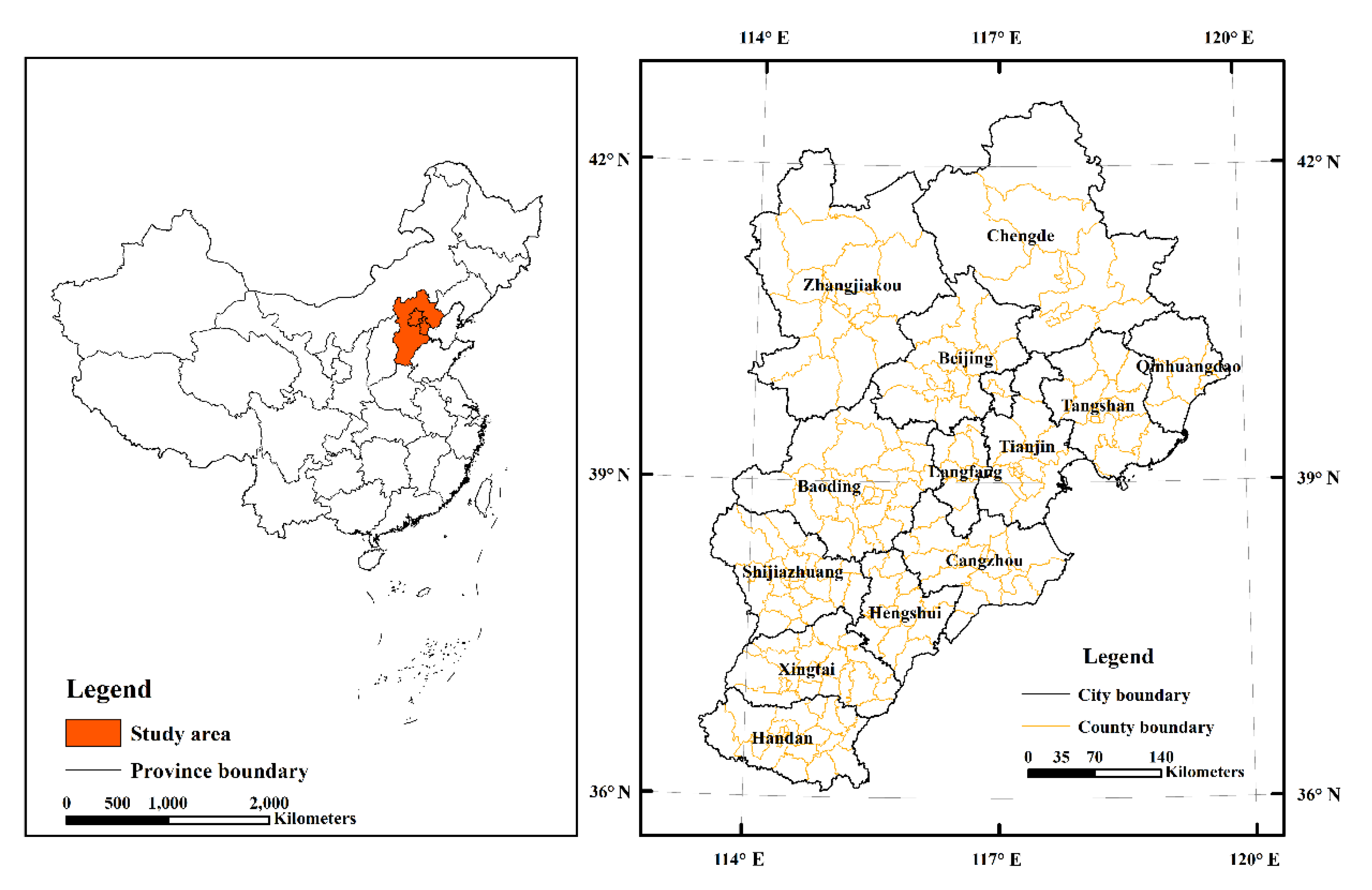
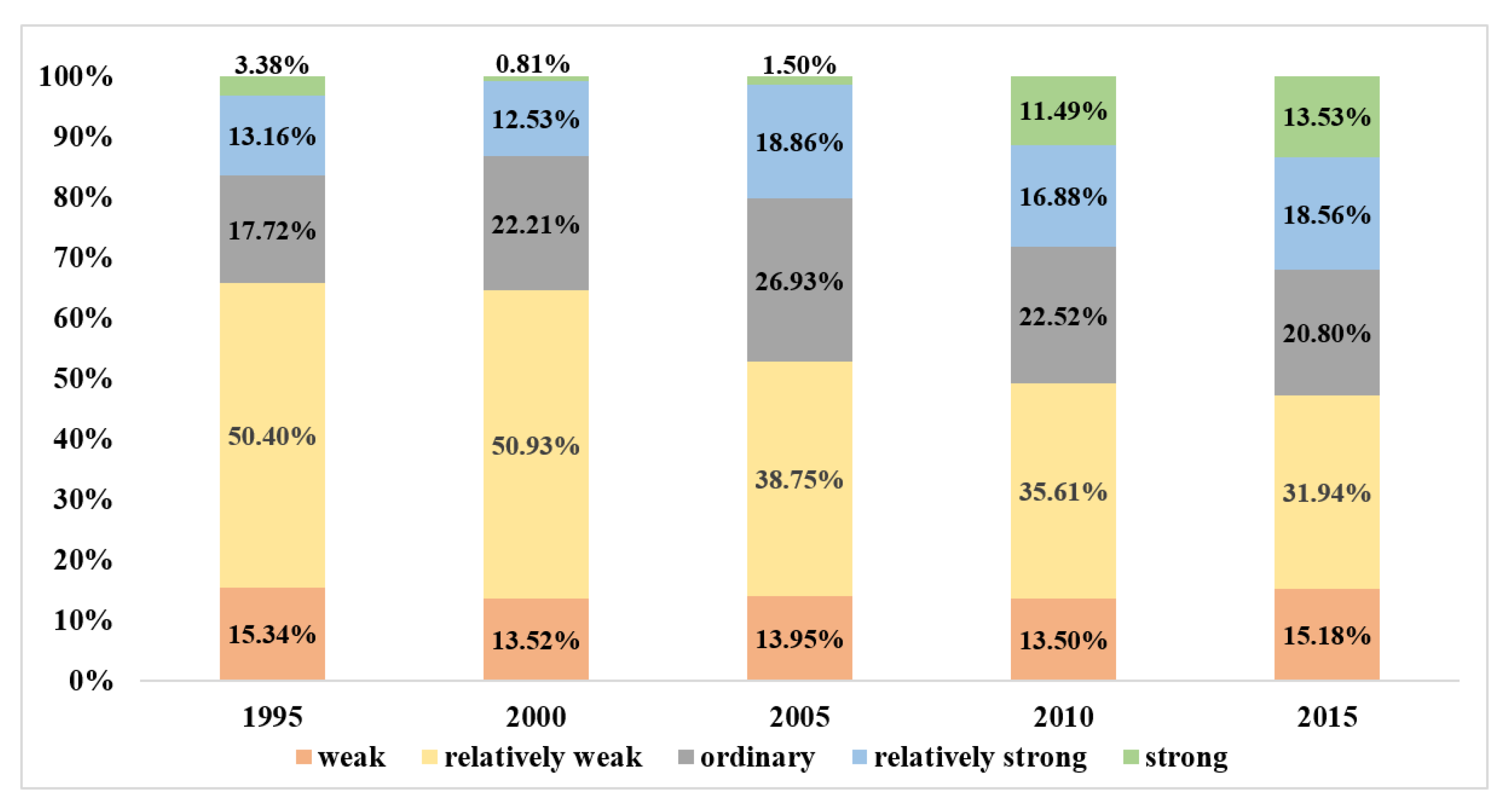

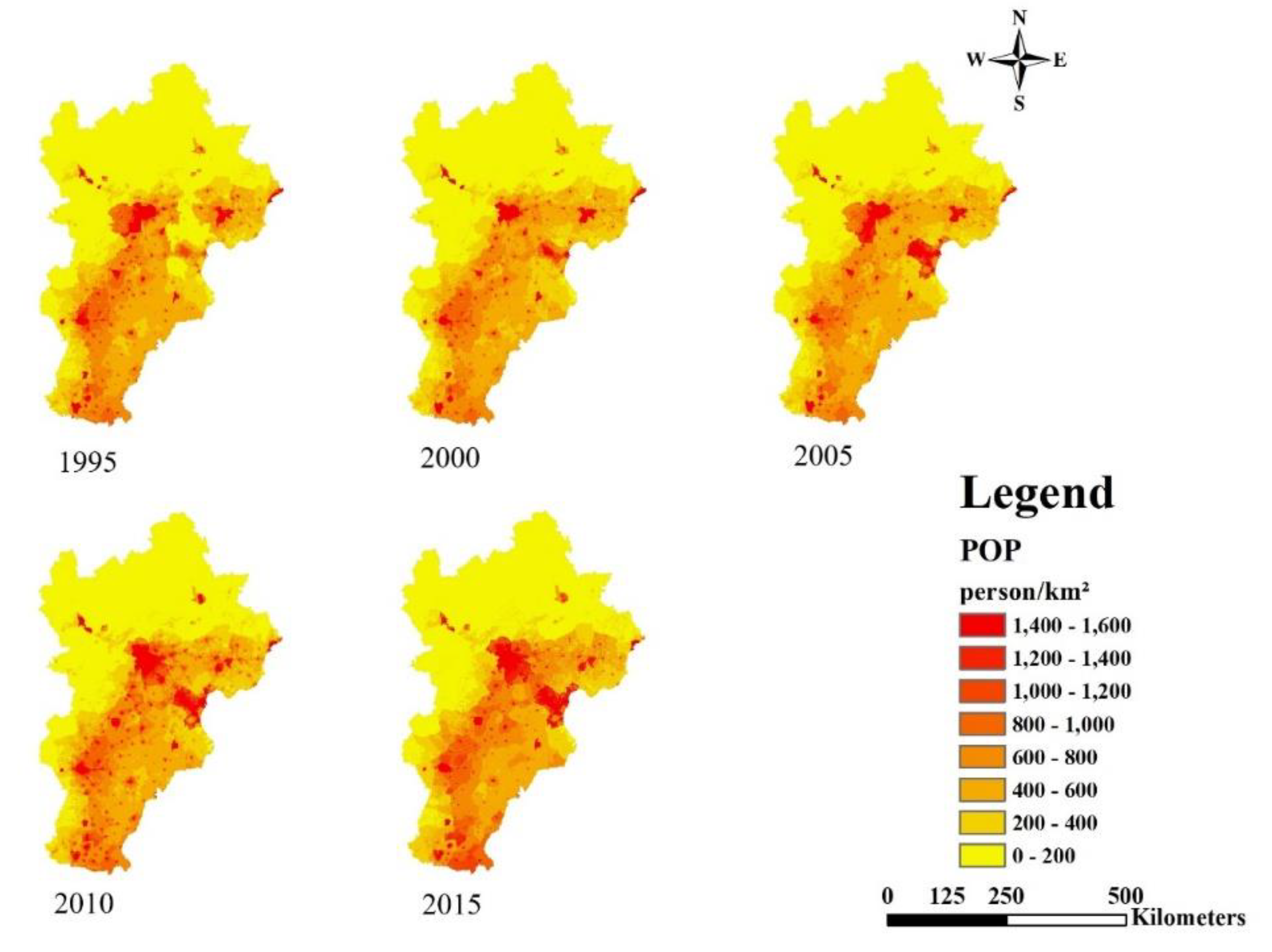
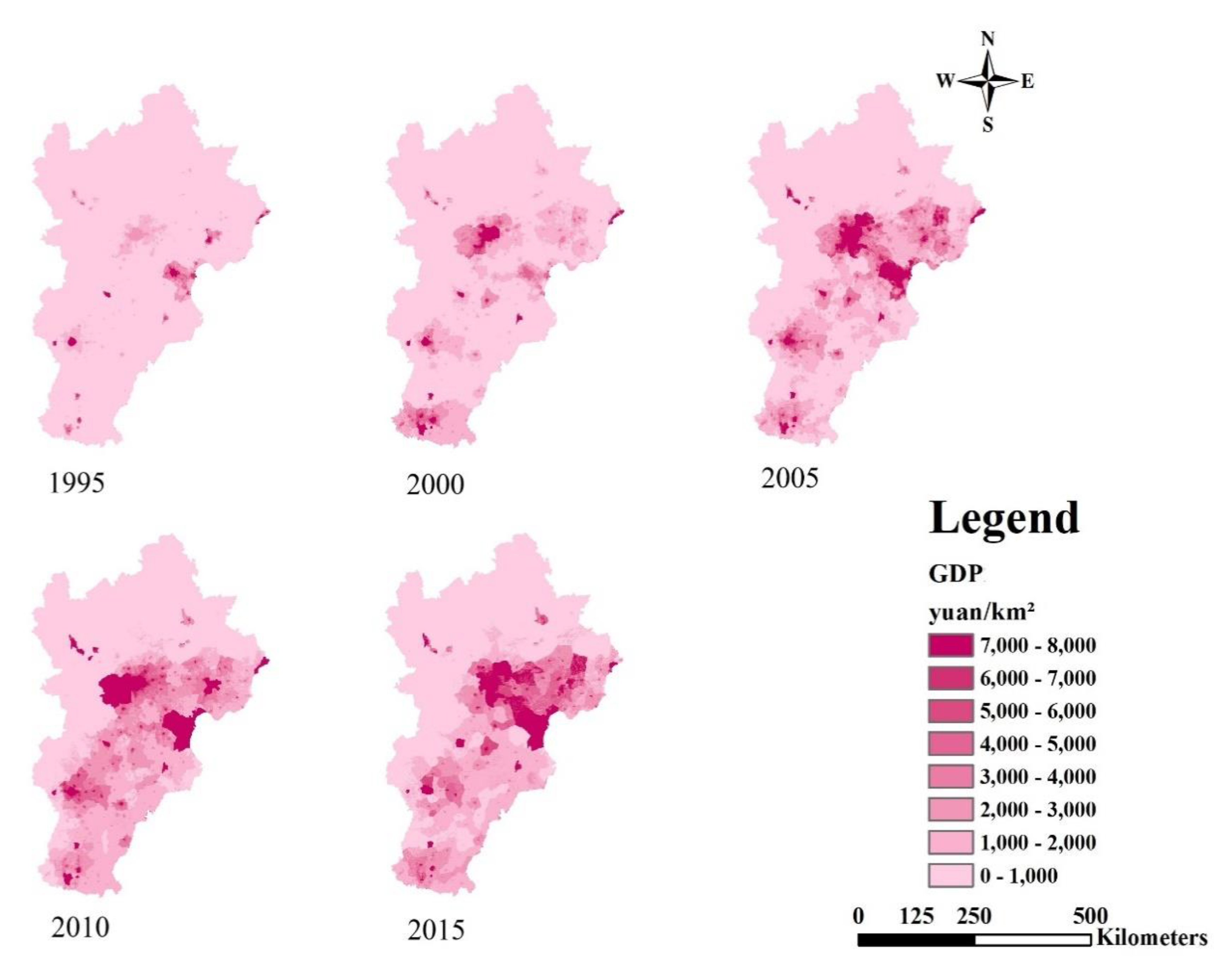
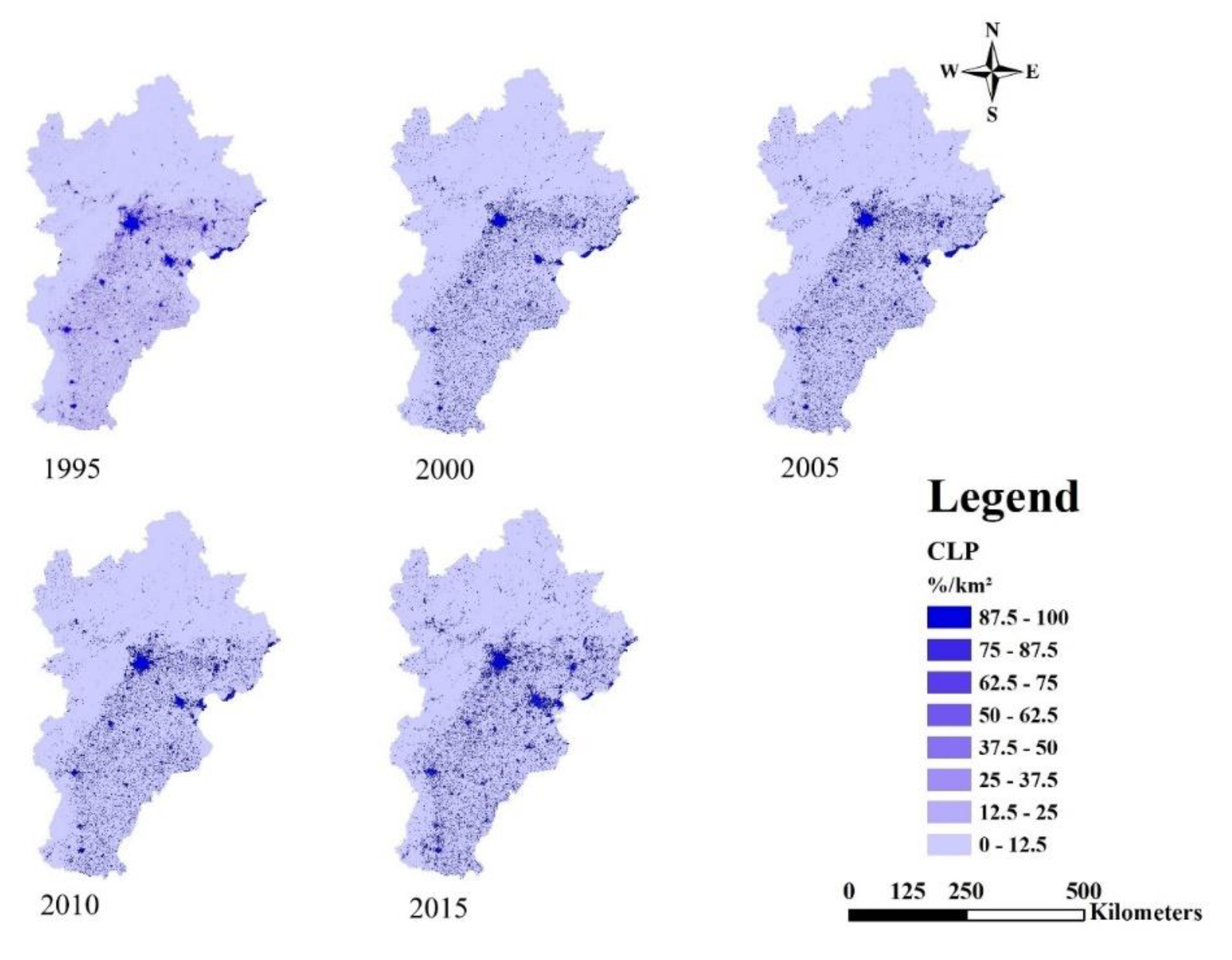
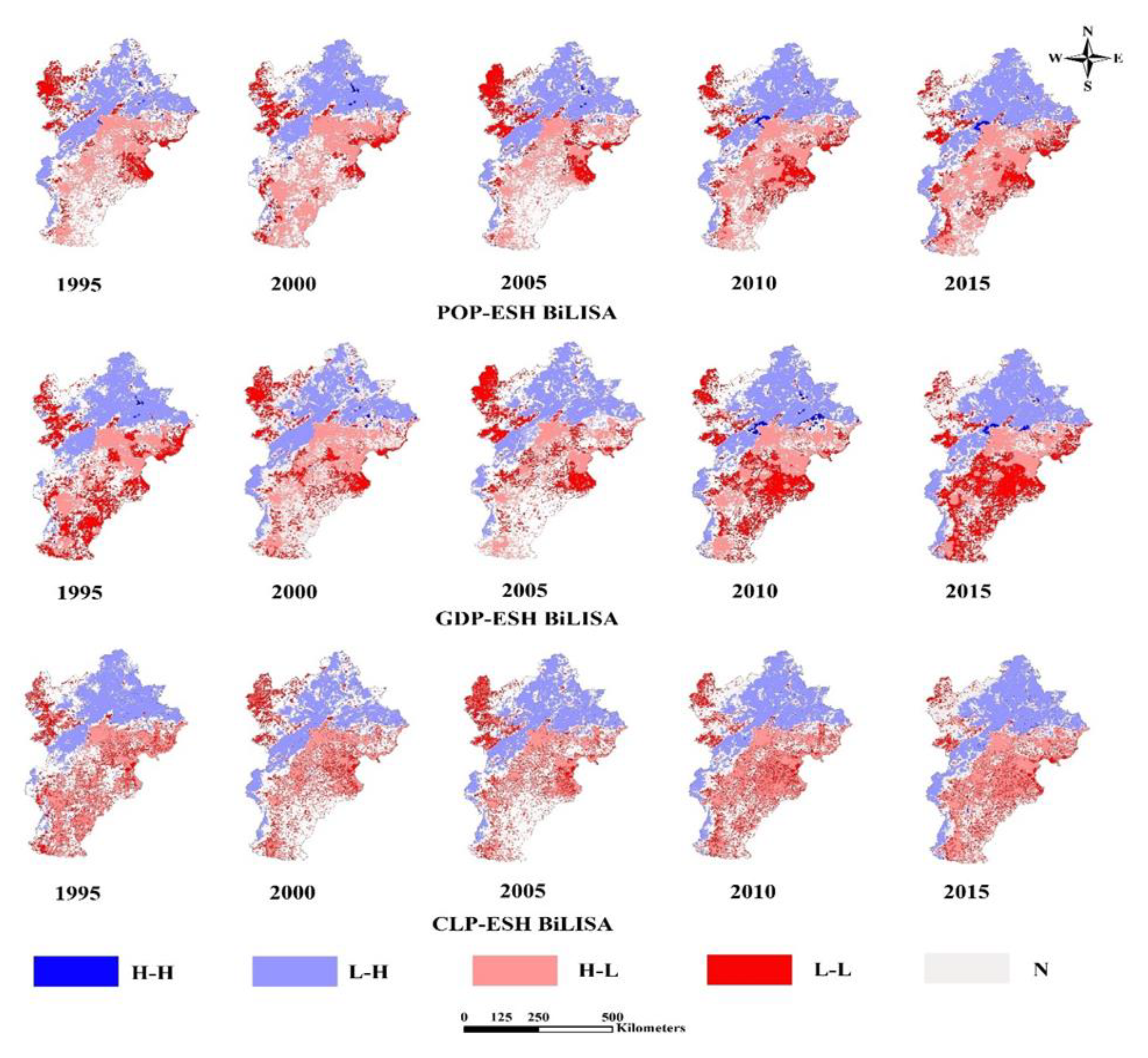
| Framework | Indicators | Number | P/N 2 |
|---|---|---|---|
| Vigor | NDVI (Normalized Difference Vegetation Index) | X1 | P |
| Organization | Shannon’s Diversity Index (SHDI) | X2 | P |
| Patch Density (PD) | X3 | P | |
| Area-Weighted Patch Fractal Dimension (AWMPFD) | X4 | P | |
| Patch Cohesion Index (COHESION) | X5 | P | |
| Contagion Index (CONTAG) | X6 | P | |
| Integral Index of Connectivity (IIC) | X7 | P | |
| Resilience | resilience value | X8 | P |
| Function | Ecosystem service value (ESV) 1 | X9 | P |
| Ecosystem Service | Land Use Types | ||||||
|---|---|---|---|---|---|---|---|
| Forest | Grassland | Water | Cropland | Built-Up Land | Unused Land | ||
| Provisioning Service | Food production | 406.20 | 406.20 | 1306.91 | 1518.85 | 0.00 | 0.02 |
| Raw materials | 936.03 | 600.47 | 494.51 | 688.78 | 0.00 | 0.02 | |
| Regulating service | Gas regulation | 3090.68 | 2136.98 | 1766.10 | 1200.95 | 0.00 | 0.01 |
| Climate regulation | 9254.36 | 5633.86 | 4503.56 | 635.80 | 0.00 | 0.09 | |
| Waste treatment | 2755.12 | 1854.41 | 9113.08 | 176.61 | 0.00 | 0.15 | |
| Water regulation | 6799.49 | 4132.67 | 153,014.90 | 565.15 | 0.00 | 0.17 | |
| Supporting service | Soil formation & protection | 3761.79 | 2596.17 | 2136.98 | 1783.76 | 0.00 | 0.11 |
| nutrient cycling | 282.58 | 194.27 | 158.95 | 211.93 | 0.00 | 0.01 | |
| Biodiversity maintenance | 3426.23 | 2366.57 | 6375.62 | 229.59 | 0.00 | 0.10 | |
| Cultural service | Recreation & Aesthetic value | 1501.19 | 1042.00 | 4344.61 | 105.97 | 0.00 | 0.05 |
| Type | Year | 1995 | 2000 | 2005 | 2010 | 2015 |
|---|---|---|---|---|---|---|
| GDP | Moran’s I | −0.237 | −0.281 | −0.295 | −0.371 | −0.168 |
| z-value | −311.34 | −377.1 | −378.89 | −481.39 | −228.31 | |
| p-value | 0.01 | 0.01 | 0.01 | 0.01 | 0.01 | |
| POP | Moran’s I | −0.366 | −0.359 | −0.355 | −0.276 | −0.267 |
| z-value | −447.5 | −445.52 | −443.55 | −364.02 | −351.55 | |
| p-value | 0.01 | 0.01 | 0.01 | 0.01 | 0.01 | |
| CLP | Moran’s I | −0.351 | −0.362 | −0.388 | −0.407 | −0.429 |
| z-value | −401.83 | −397.54 | −426.09 | −444.28 | −493.85 | |
| p-value | 0.01 | 0.01 | 0.01 | 0.01 | 0.01 |
Publisher’s Note: MDPI stays neutral with regard to jurisdictional claims in published maps and institutional affiliations. |
© 2021 by the authors. Licensee MDPI, Basel, Switzerland. This article is an open access article distributed under the terms and conditions of the Creative Commons Attribution (CC BY) license (http://creativecommons.org/licenses/by/4.0/).
Share and Cite
Wu, F.; Wang, X.; Ren, Y. Urbanization’s Impacts on Ecosystem Health Dynamics in the Beijing-Tianjin-Hebei Region, China. Int. J. Environ. Res. Public Health 2021, 18, 918. https://doi.org/10.3390/ijerph18030918
Wu F, Wang X, Ren Y. Urbanization’s Impacts on Ecosystem Health Dynamics in the Beijing-Tianjin-Hebei Region, China. International Journal of Environmental Research and Public Health. 2021; 18(3):918. https://doi.org/10.3390/ijerph18030918
Chicago/Turabian StyleWu, Fan, Xiaoke Wang, and Yufen Ren. 2021. "Urbanization’s Impacts on Ecosystem Health Dynamics in the Beijing-Tianjin-Hebei Region, China" International Journal of Environmental Research and Public Health 18, no. 3: 918. https://doi.org/10.3390/ijerph18030918
APA StyleWu, F., Wang, X., & Ren, Y. (2021). Urbanization’s Impacts on Ecosystem Health Dynamics in the Beijing-Tianjin-Hebei Region, China. International Journal of Environmental Research and Public Health, 18(3), 918. https://doi.org/10.3390/ijerph18030918





